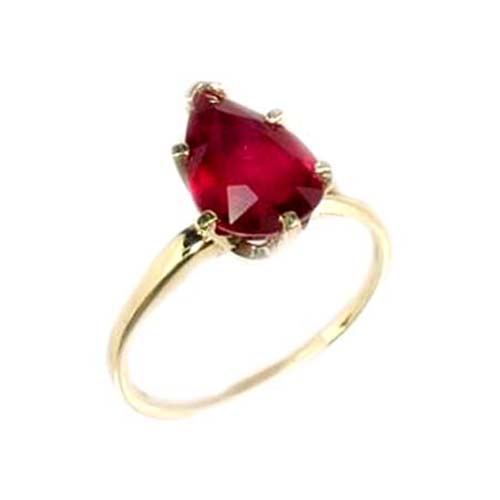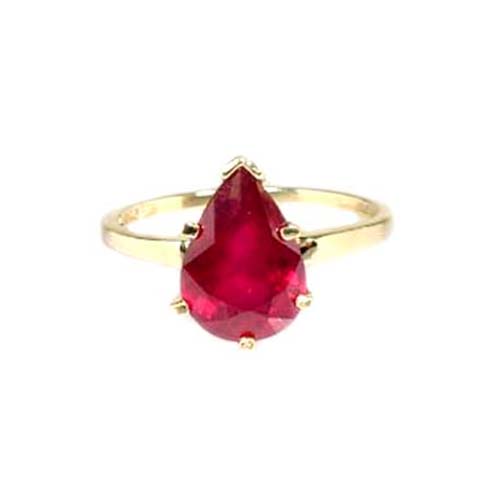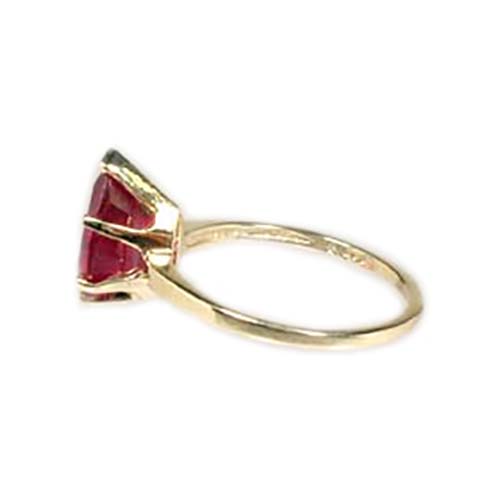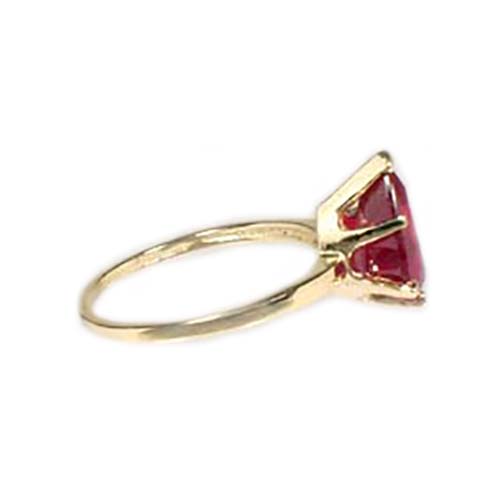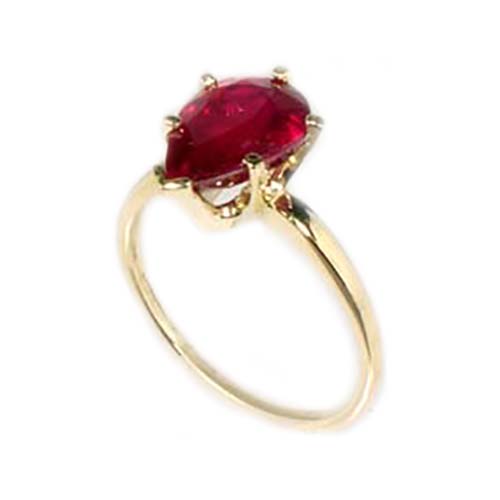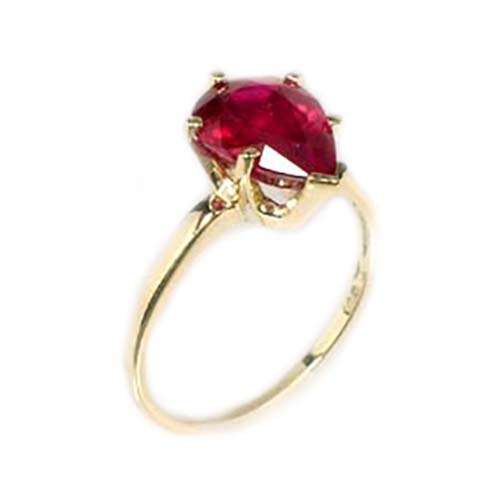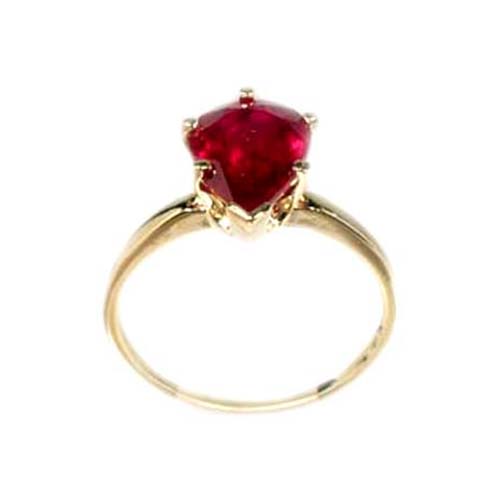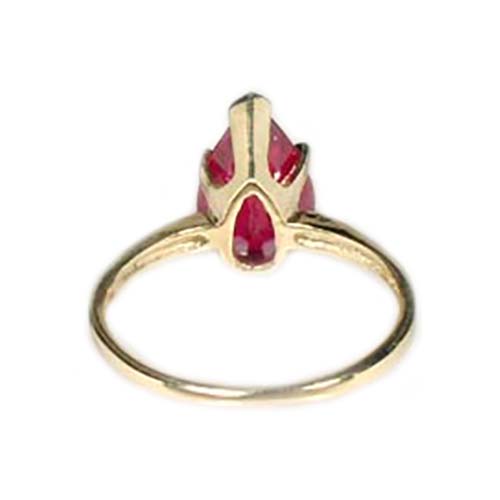Red Ruby "Pear" Cut Ancient Hebrew Wisdom 14kt Gold Ring #61205 $1299.99
Antique 19th Century Handcrafted Genuine Natural Faceted Three Carat Blood Red Ruby Pear. Mounted into high quality solid 14kt gold (not cheap gold electroplate) ring.
ORIGIN: Handcrafted in Russia, 19th Century. Contemporary USA Manufactured High Quality 14kt Solid Gold Ring (Size 7 – Resizing Available).
SIZE: Length: 10 1/2mm. Breadth: 7 1/4mm. Depth: 4 3/4mm. Measurements approximate.
WEIGHT: 3.02 carats.
NOTE: Resizing is available. This setting is also available in 14kt solid white gold as well as sterling silver. Write us for pictures and prices.
$1299.99
Details
The Bible makes numerous mentions of ruby, first as one of the twelve precious stones created by God when he created mankind. Ruby is then described as “the lord of gems” when one was given to Aaron on the command of God. And ruby adorned Aaron's breastplate and was symbol of Judah. The Bible also frequently states that the high value of ruby was only exceeded by wisdom and by virtuous women, implying that ruby indeed was exceptionally valuable. In the classical world, rubies from Afghanistan, Ceylon, and Burma were traded in the ancient port cities of the Eastern Mediterranean (often by Phoenicians), and from there traveled throughout Europe.
Celebrating our historical inheritance here's a very nice quality 19th century antique hand faceted “pear” cut ruby. The gemstone was hand crafted by a 19th century Russian artisan, part of an heritage renown for the production of the elaborate gemstones and jewelry of the Czars of Medieval, Renaissance, and Victorian Russia. Originally used in indigenous jewelry, this sparkling precious gemstone is transparent, not translucent, with a highly desirable blood red color, and vibrant sparkles of fiery, brilliant red flashes. It is "eye clean" even to close scrutiny, and is absolutely transparent as opposed to lower value translucent rubies. Of course most ruby gemstones are anywhere from lightly to heavily blemished. An almost hallmark characteristic of natural ruby is the presence of blemishes composed of colorless crystalline material.
The colorless crystals might be eye-visible, in the forms of seams; or might be in the form of microscopic crystals which while not individually discernible, nonetheless cause the ruby to be "hazy" in character, rendering the gemstone translucent, or even opaque, rather than transparent. Unfortunately most transparent "rubies" sold even by the largest and most reputable retailers in the United States are synthetic (read the fine print; and the same is true of emeralds and sapphires). While this particular specimen might not be anywhere near flawless, it is eye clean. However examination with a jeweler’s loupe (or examination of the accompanying photo enlargements) reveals a scattered sprinkling of minute blemishes in the form of tiny specks of colorless crystalline material (again, quite characteristic of natural ruby).
However these minute, pin-prick spicules of colorless crystalline material y are not discernible by eye. Even if you hold the ruby right up to your nose and inspect it intently. However they are fairly easy to discern in a 5x jeweler's loupe, and can (with difficulty) be seen in these photo enlargements if one scrutinizes them very intently. Nonetheless we guarantee you will be mesmerized and dazzled by the rich color, and sparkling, fiery beauty of this natural ruby precious gemstone. While in these photo enlargements the minute specks of colorless crystalline material seem quite obvious, they are not discernible with the naked eye.
Whatever sins the critic might find, to the eye it is simply a gorgeous blood red ruby of even color, the dispersed miniscule blemishes are only discernible under magnification. The deep, blood red gemstone possesses very handsome luster and really exceptional sparkle as well! If you hold this gemstone in the light between thumb and forefinger you can appreciate the transparency of this gorgeous precious gemstone. And while this gorgeous precious gemstone is not absolutely flawless, it is most certainly toward the higher end of the quality spectrum.
The setting is of contemporary origin. It is a high quality setting manufactured by one of the USA’s leading semi-custom mount producers. It is constructed of solid 14kt yellow gold (NOT merely gold plate). The ring is also available in white gold, and there are many other ring styles available. Some are most costly, some less. If you would like to see the other ring styles available for this gemstone, just contact us, we would be happy to share them with you. We do have the ability to have the ring sent out for resizing if requested. Additionally, if preferred, the mounting is also available in sterling silver (at reduced cost).
As might be expected under magnification the gemstone shows the unmistakable, hallmark characteristics of having been hand crafted. The coarseness of the antique, handcrafted finish is considered desirable to most gemstone aficionados, and is not considered a detriment, or detract from the value of a gemstone. These characteristics are not only expected of hand-finished gemstones, many believe that such antique hand-crafted gemstones possess much greater character and appeal than today's mass-produced, laser-cut gemstones. Unlike today’s computer controlled machine produced gemstones that approach flawlessness in a perfect finish, the cut and finish of an antique, handcrafted gemstone such as this is the legacy of an artisan who lived two centuries ago.
Handcrafted though it may be the gemstone possesses superb luster and color, fabulous sparkle, and to the eye is absolutely transparent. But of course that does not mean it is entirely flawless. True, the blemishes it possesses are discerned by the naked eye. As stated, to casual scrutiny it is simply a stunning blood red ruby gemstone of even color. However in the accompanying photo enlargements you can just barely discern a scattering of minute speckles of colorless crystalline material. Of course much the same may said about almost any antique gemstone of natural origin. An absolutely flawless gemstone simply is not the rule in nature. Most absolutely flawless gemstones will upon close examination be revealed to be synthetic, as perfect gemstones are the realm of laboratory-produced gemstones, not Mother Nature. You might also notice under magnification occasional irregularities in the cut and finish.
Naturally these characteristics are not only expected of hand-finished gemstones, you must also consider that two centuries ago the mining techniques even possible then, let alone in practice, did not allow the ultra deep mining operations which are so commonplace today. Keep in mind two centuries ago mankind was more or less limited to surface deposits or near surface deposits of gemstones. Higher quality gemstones which today are routinely mined from beneath hundreds of meters, even kilometers beneath the earth's surface, were simply inaccessible then. It is precisely for these reasons antique gemstones must be appreciated as antiques first, gemstones second. The relatively superlative quality of contemporary gemstones routinely mined from deep beneath the earth's surface today were simply not accessible two centuries ago, or at least, only rarely so. However for most, the unique nature and character of these antique gemstones more than makes up for the blemishes found within the gemstones, as well as the cutting irregularities common to handcrafted gemstones, all of which are by and large (if at all) are only visible under magnification.
RUBY HISTORY: The name ruby comes from the Latin "rubeus" (red). In the ancient world ruby was believed to possess magical powers, and was worn as a talisman for protection from plagues, poison, sorrow, and evil spirits. The ruby symbolized freedom, charity, dignity and divine power, and was associated with fire and blood, implying warmth and life for mankind. Some ancient cultures believed that rubies, as well as other gemstones, grew on trees, just like fruit. The rubies would begin budding as small white gems, and would slowly grow and ripen, turning red in the light of the sun. When the ruby was saturated with red color, it was ready to be plucked. In the classical world, rubies from Afghanistan, Ceylon, India were traded in the ancient port cities of the Eastern Mediterranean (often by Phoenicians), and from there traveled throughout Europe. However it is believed that most of the ancient world’s ruby came from Ceylon, where evidence suggests ruby may have been mined for the past 20,000 years. Archaeologists have uncovered ancient Etruscan jewelry with Celanese ruby which dates back to the seventh century B.C. However scientists believe that ruby has also been mined since Paleolithic and Neolithic times as well, as tools have been excavated by archaeologists dating both to the Bronze Age as well as backwards into the Stone Age.
In ancient literature, the ruby was described both by the fourth century B.C. Greek Philosopher/Scientist Theophratus (student and successor of Plato and Socrates) as well as by Pliny, the first century A.D. Roman historian and naturalist. In ancient Rome the ruby was associated with the principles of justice and its administrators (the judicial system). Ancient literature from China indicates that ruby was traded along the northern silk route, moving westward into Europe. The Bible as well makes numerous mentions of ruby, first as one of the twelve precious stones created by God when he created mankind. Ruby is then described as “the lord of gems” when one was given to Aaron on the command of God. And ruby adorned Aaron's breastplate and was symbol of Judah. The Bible also frequently states that the high value of ruby was only exceeded by wisdom and by virtuous women, implying that ruby indeed was exceptionally valuable. The Greeks believed that the "fire" evidenced by a ruby's red coloration could melt wax. Greeks legends speak about huge rubies which were given to Heraclea by the female stork to lighten her room as a token of her kindness. The ancient populations of the Mediterranean also believed that the color of a ruby would change mirroring changes in the health of its owner, and that the color would drain from a ruby at the moment its owner died. In Antiquity and through the Middle Ages it was believed that the cosmos was reflected in gemstones. Ruby was associated with the planet Mars.
Ruby was deemed to be the most precious of gemstones not only in the Bible, but also in ancient Sanskrit writings. In Sanskrit, an ancient language of India, ruby was called "ratnaraj", which means "King of Gems". To them, this fiery stone burned with an inextinguishable fire, capable of boiling the water in which it was placed. Ancient Indian legends said that God first created ruby and later created man to possess it, and that he who offered rubies to the gods would be reincarnated as a powerful king or emperor. In ancient India rubies were also sorted into upper class, middle class, and lower class stones in relation to their color, flawlessness and beauty. Much like Indian society today, no inferior ruby was allowed contact with an upper class ruby because it was believed the low-caste ruby would contaminate the better one, thereby diminishing its magical powers. In nearby ancient Ba it was felt a ruby must not just be worn, but embedded in the skin to become part of the body, thus making the wearer invulnerable. Up in time through Medieval Europe, rubies were worn as a talisman for protection against unhappiness, lightening and upsetting dreams. The ruby was also believed to encourage bliss, and was used to treat fever and heart disorders relating to blood flow through the ventricles. It was also believed that when worn on the left hand or in a brooch on the left side, ruby enabled the wearer to live in peace among enemies.
Ruby was greatly valued in the Medieval Arab world. There are many references to ruby in ancient Arabic literature, including many references to “yakut”, a term used for red corundum (ruby) during the sixth through tenth centuries, culminating in a noteworthy treatise by the 11th century Arab scholar Al-Biruni, who conducted specific gravity determinations on a whole series of gemstones. Throughout Medieval Central Asia, the Near East, and China ruby was used to ornament armor, scabbards, and harnesses of noblemen. Rubies were laid beneath the foundation of buildings to secure good fortune to the structure. Much of the ruby reaching early Medieval Europe came from Badakshan, on the border between present-day Tajikistan and Afghanistan. Marco Polo described visiting these mines in his accounts of his travels. Later Medieval Europe’s rubies came principally from the border region Siam (present-day Thailand).
In Medieval Europe, rubies were considered even more valuable than diamonds. In 16th century ruby was priced 8 times higher than diamond. Rubies were viewed as a stone of prophecy, used by medieval shamans and sorcerers to divine the future. Ruby was also worn as a talisman, as it was believed that the stone darkened when danger was near and then returned to its original color when the danger was past. It was believed that wearing ruby would attract good health, wisdom, fortune, and true love. Ruby was also thought to be an antidote to poisoning as well. In England, ruby was used for royal coronation rings. Medieval Europe also believed that ruby had important medical applications. A thirteenth century prescription to cure liver problems called for powdered ruby, and it was also believed that when rubbed on the skin, ruby would restore youth and vitality. Ivan the Terrible of Russia stated that rubies were good for the heart, brain and memory.
Rubies are mined all over the world, but the highest quality gemstones come from Ceylon, and Siam, then India, Madagascar, Russia, Zimbabwe, Kenya, Tanzania, Mexico, and North Carolina in the USA. Ruby is the red variety of corundum, the second hardest natural mineral known to mankind. The non-red variety of corundum is Sapphire. Sapphires are well known among the general public as being blue, but can be nearly any color. A ruby's color is due to a trace of chromic oxide; the amount of this trace mineral determines the depth of color. The most sought after shade of red for ruby is often given the name "pigeon blood red", but ruby can be any shade of red up to almost pink
Throughout the history of the ancient world, gemstones were believed capable of curing illness and providing protection. Found in Egypt dated 1500 B. C., the "Papyrus Ebers" offered one of most complete therapeutic manuscripts containing prescriptions using gemstones and minerals. Gemstones were not only valued for their medicinal and protective properties, but also for educational and spiritual enhancement. In these as well as other ancient cultures, it was believed that rubies brought health, wealth, wisdom, and success in love to those who wore them. The ruby was associated with the sun, and was thought to preserve both mental and physical health. The medicinal uses of ruby included its use to overcome exhaustion and calm hyperactivity. Ruby was also used to detoxify the body and blood, treat fevers, diseases, and restricted blood flow. Wearing ruby was believed to benefit the heart and circulatory system and stimulate the adrenals, kidneys, reproductive organs and spleen. According to one ancient text, ground to a fine powder and placed on the tongue, ruby was used to cure blood diseases, stop bleeding, ensure good health, bring peace, and treat indigestion. Ruby was also believed to be an effective treatment for backaches.
On the metaphysical plane, for thousands of years, ruby was considered the stone of love, passion, and power. It was believed to represent masculinity, nobility, and valor in men; pride, seductiveness, and passion in women. Ruby was believed to restore vital life forces and increase energy, vigor, and zest for life. Ruby was also regarded as the stone of courage, ancient sources citing that the wearer of ruby could pass through life without fear of evil or misfortune, and that ruby would make the wearer invulnerable to wounds, an especially useful attribute for ancient warriors. Wearing ruby was believed to strengthen the wearer during times of controversy or dispute, to shield against physical attack, to enhance creativity and spirituality, and to inspire confidence and self-esteem. Ruby was also believed to be capable of arousing passion and enthusiasm and attracting sexual activity. Even today in Asia ruby is worn by businessmen who believe that ruby improves motivation and the setting of goals, and promotes dynamic leadership. They are believed to heighten one’s state of mind, sharp, hyper-aware and focused.

